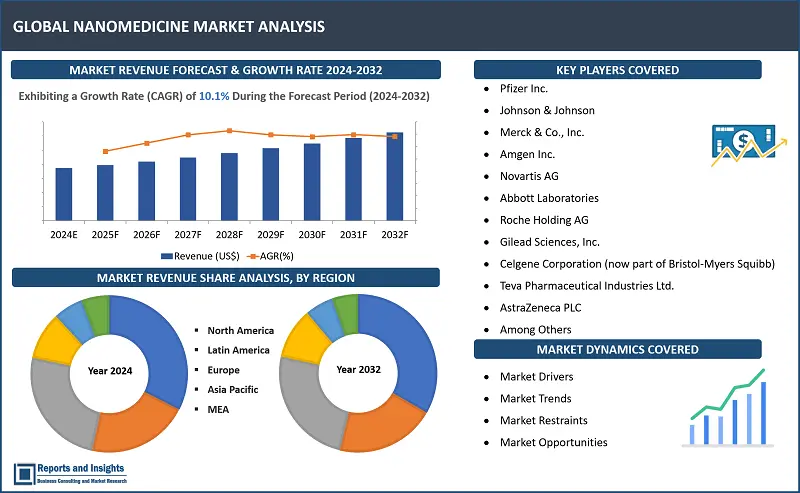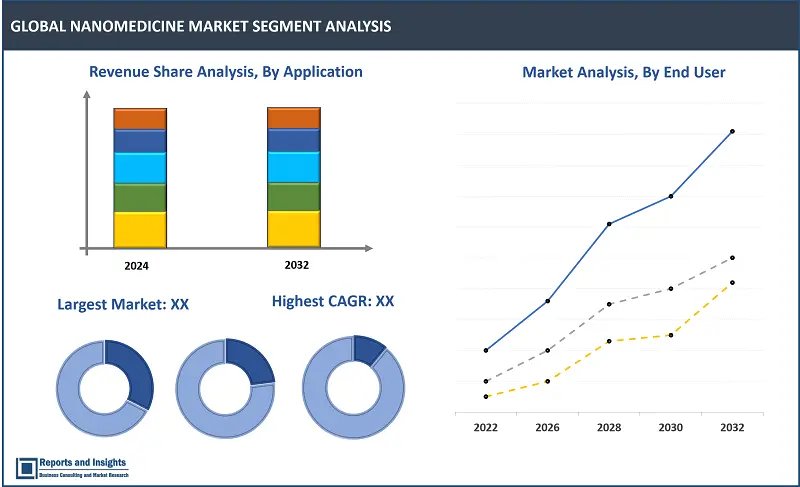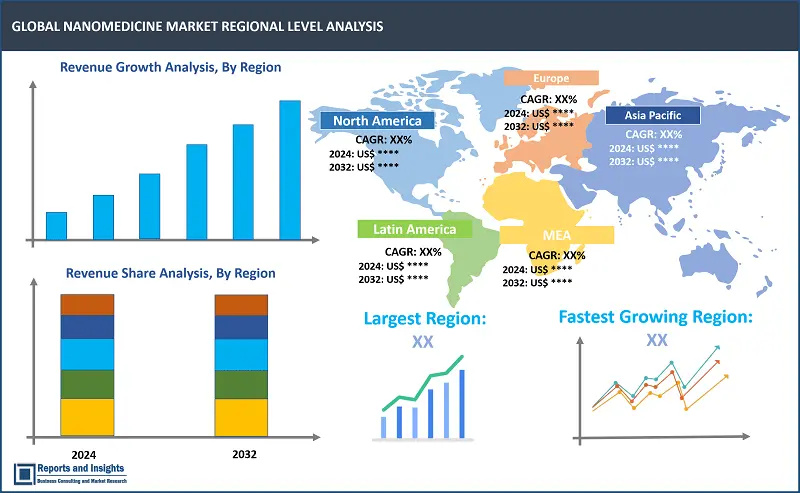Market Overview:
"The nanomedicine market was valued at US$ 240.7 million in 2023, and is expected to register a CAGR of 10.1% over the forecast period and reach US$ 572.2 million in 2032."
|
Report Attributes |
Details |
|
Base Year |
2023 |
|
Forecast Years |
2024-2032 |
|
Historical Years |
2021-2023 |
|
Nanomedicine Market Growth Rate (2024-2032) |
10.1% |
Nanomedicine is a specialized branch of medicine involving the application of nanotechnology in healthcare to diagnose, treat, and prevent diseases at the molecular level. Defined technically, nanomedicine leverages particles within the nanoscale range (1 to 100 nanometers) to precisely target cells, tissues, and organs, enabling high efficacy and minimal side effects. The importance of nanomedicine is in its potential to revolutionize healthcare by enabling development of personalized treatments, earlier disease detection, and innovative drug delivery systems.
Nanomedicine is being used for targeted drug delivery, which enhances treatment effectiveness and reduces toxicity; medical imaging, providing improved diagnostic accuracy; and regenerative medicine, offering novel solutions for tissue and organ repair. Techniques in nanomedicine involve complex engineering processes such as top-down lithography and bottom-up self-assembly, ensuring precise control over particle size and functionality. Medical applications of nanomedicine extend across oncology, cardiology, neurology, and infectious diseases. For instance, nanoparticles can be engineered to selectively target cancer cells, delivering chemotherapy drugs directly to tumors and sparing healthy tissue. Nanoparticles are used in advanced therapeutic approaches due to their ability to overcome biological barriers and provide localized treatment.
Current trend in the market include the development of multifunctional nanocarriers for combinatorial therapies and integration of Artificial Intelligence (AI) for personalized treatment strategies, and advancements in nanomaterial design and fabrication are contributing to improved biocompatibility and patient outcomes. Also, emerging applications comprise precision oncology, nano-immunotherapies, and RNA-based treatments, all of which are reshaping the future of medicine.

Nanomedicine Market Trends and Drivers:
A key factor driving the growth of the nanomedicine market is increasing prevalence of chronic diseases such as cancer, cardiovascular conditions, and neurodegenerative disorders, necessitating need for more targeted and effective treatment options, where nanomedicine emerges as an excellent option. Also, steadily shifting consumer preferences towards personalized medicine approaches, which nanomedicine supports through tailored drug delivery and treatment plans, coupled with technological advancements, including the development of multifunctional nanoparticles and advanced imaging techniques, are factors further supporting growth of the market. As awareness regarding nanomedicine continues to rise, adoption in early diagnosis, precision oncology, and regenerative medicine is increasing, along with innovations in targeted drug delivery, medical imaging, and vaccine development.
In addition, nanomedicine-related programs and initiatives, such as government funding for Research and Development (R&D), is serving to accelerate innovation and shape regulatory support. Healthcare and medical regulations, particularly regarding safety and efficacy standards, guide the industry toward reliable and effective nanomedicine applications, and these factors are collectively expected to highlight the growing significance of nanomedicine in transforming healthcare outcomes and patient experiences worldwide.
Nanomedicine Market Restraining Factors:
Nanomedicine holds significant potential for transforming healthcare, but there are several factors restraining wider adoption and use currently. For one, regulations and concerns related to safety owing to complexities this technology brings along are having an impact on more rapid traction. Regulatory bodies such as U.S. Food and Drug Administration (FDA) and the European Medicines Agency (EMA) closely monitor nanomedical products for potential safety risks and efficacy, and need for these products to be compliant with new and evolving regulations can delay product approvals and launches, and also increase development costs. Development and production costs are also factors slowing down potential growth, as manufacturing and research processes in nanomedicine are sophisticated and costly, and need for advanced equipment, specialized materials, and skilled personnel adds up to the overall costs. As a result, consumers are faced with high costs for treatment, which can restrain affordability and wider adoption, especially in lower-income regions and countries.
In addition, the need for further R&D initiatives, despite major advances in the field, are still significantly challenging to understand the long-term effects and behavior of nanoparticles in the human body, and inadequate knowledge regarding potential toxicity, bioaccumulation, and unanticipated interactions can hinder progress in nanomedicine R&D. These challenges may lead to hesitance among researchers and healthcare providers to confidently accept and adopt nanomedicine applications.
Moreover, the use of nanoparticles in medical treatments presents potential risks, such as unexpected side effects, immune responses, or off-target effects. For example, while targeting specific cells is a major advantage of nanomedicine, unintentional interactions with healthy cells or tissues could lead to adverse outcomes. This uncertainty can deter both medical professionals and patients from exploring nanomedicine-based therapies.
Other negative trends in the market include competition from other advanced medical technologies and treatment options, such as monoclonal antibodies, cell therapies, and traditional drug delivery systems. These established alternatives may offer similar benefits without the uncertainties associated with nanomedicine. Additionally, the lack of standardized protocols and quality control measures can result in inconsistent product performance, potentially eroding trust in nanomedicine products.
Nanomedicine Market Opportunities:
Leading companies in the nanomedicine market can enter into collaborations and partnerships with research institutions, universities, and with other industry players, which can facilitate access to new technologies and result in research breakthroughs and development of innovative products, and also expand market reach. Expanding presence in emerging markets can offer significant potential for further growth owing to increasing healthcare spending and rising prevalence of chronic diseases, and increasing modernization of healthcare facilities and access to healthcare infrastructure. This strategy can also enable companies to expand existing bases and tap into new consumer bases and capitalize on the growing demand for advanced medical solutions.
Opportunities driven by the rising trend of personalized medicine can be leveraged by investing in creation of tailored treatments for individual patients, and this strategy can lead to increased efficacy and patient satisfaction, thereby cultivating patient loyalty and enhancing the revenue streams. Companies can also focus on diversification of product portfolio, and enhance offerings, including developing combination therapies, multifunctional nanocarriers, and also cater to a wider range of medical conditions, and this approach can open up additional revenue streams.
Major companies can also enter into strategic agreements and adopt mergers and acquisitions to expand their respective capabilities, gain access to new markets, and enhance their product lines. Furthermore, investing in such strategies and innovation can position companies as leaders in the nanomedicine market and enable better capability to meet evolving needs in the healthcare sector and for patients, and this can also secure long-term success in a dynamic market.
Nanomedicine Market Segmentation:

By Application
- Drug Delivery
- Diagnostics and Imaging
- Regenerative Medicine
- Vaccine Development
Among the application segments, the drug delivery application segment is expected to account for the largest revenue share in the nanomedicine market. This projected growth is supported by growing importance as a result of the precision and efficacy of nanomedicine in targeting specific cells, leading to improved therapeutic outcomes and minimized side effects. Nanoparticle-based drug delivery systems can also enhance bioavailability and enable sustained release of drugs, and these advantages make drug delivery a key focus area and application, for both researchers and healthcare providers, and this factor is expected to support growth of the market over the forecast period.
By Nanoparticle Type
- Liposomes
- Polymeric Nanoparticles
- Metallic Nanoparticles
- Carbon Nanotubes
Among the nanoparticle type segments, the liposomes segment is expected to account for the largest revenue share over the forecast period. Liposomes offer excellent biocompatibility and can encapsulate a variety of drugs, allowing for targeted delivery to specific cells or tissues. Liposomes also provide protection for sensitive drugs and can improve solubility and stability, and these benefits make liposomes a preferred choice for pharmaceutical companies and healthcare providers.
By Disease Indication
- Oncology
- Infectious Diseases
- Cardiovascular Diseases
- Neurological Disorders
The oncology segment among the disease indication segments is expected to account for the largest revenue share, and this can be attributed to nanomedicine offering targeted drug delivery, enhancing the effectiveness of cancer treatments while reducing side effects and improving patient outcomes. Oncology also plays a critical role in early cancer diagnosis through advanced imaging techniques, and with the high prevalence of cancer globally and the demand for more precise and less toxic treatments, the oncology segment is expected to continue to account for a significantly large and incline revenue share in the nanomedicine market.
By End User
- Hospitals and Clinics
- Research and Academic Institutions
- Pharmaceutical and Biotechnology Companies
- Diagnostic Laboratories
Among the end user segments, the hospitals and clinics segment is expected to account for the largest revenue share over the forecast period. Healthcare facilities play a central role in the adoption and integration of advanced medical technologies, including nanomedicine, and hospitals and clinics are at the forefront of administering treatments, conducting diagnostics, and performing surgeries, making them key end users of nanomedicine products. Also, the growing demand for targeted therapies and precision medicine is expected to support adoption of nanomedicine in these settings, and drive substantial revenue growth of this segment.
By Region

North America
- United States
- Canada
Europe
- Germany
- United Kingdom
- France
- Italy
- Spain
- Russia
- Poland
- Benelux
- Nordic
- Rest of Europe
Asia Pacific
- China
- Japan
- India
- South Korea
- ASEAN
- Australia & New Zealand
- Rest of Asia Pacific
Latin America
- Brazil
- Mexico
- Argentina
Middle East & Africa
- Saudi Arabia
- South Africa
- United Arab Emirates
- Israel
- Rest of MEA
The global nanomedicine market is divided into five key regions: North America, Europe, Asia Pacific, Latin America, and the Middle East and Africa. Among these regional markets, North America leads in terms of revenue share, with the United States (US) contributing significantly due to substantial investments in R&D, advanced healthcare infrastructure, and strong regulatory support. Europe follows closely in revenue share regard, with Germany and the United Kingdom (UK) driving innovation and adoption in the region. Asia Pacific nanomedicine market is rapidly gaining momentum, with countries such as China, Japan, and South Korea investing substantially in nanomedicine research and technology.
Some common factors driving overall market growth include rising prevalence of chronic diseases such as cancer and cardiovascular conditions, technological advancements and progress in nanotechnology enabling the development of more effective and safer medical treatments, and supportive regulatory environment facilitating research, development, and commercialization of nanomedicine products.
Leading Companies in Nanomedicine Market & Competitive Landscape:
The competitive landscape in the global nanomedicine market is dynamic and characterized by significant innovation and strategic collaborations. Leading companies are investing majorly in research and development to create advanced products and maintain a competitive edge. Partnerships with academic institutions and research organizations allow companies to access cutting-edge technologies and expertise. Strategic acquisitions and mergers help companies expand their product portfolios and market presence. In addition, companies are focusing on personalized medicine approaches to tailor treatments to individual patients, enhancing efficacy and patient outcomes. Companies are also leveraging data analytics and artificial intelligence to accelerate drug development and improve treatment precision.
Furthermore, a number of leading players are forming strategic alliances and entering into licensing agreements to gain access to new markets and technologies. By pursuing these strategies, companies can maintain their market position and expand their consumer base in the rapidly evolving nanomedicine industry.
These companies include:
- Pfizer Inc.
- Johnson & Johnson
- Merck & Co., Inc.
- Amgen Inc.
- Novartis AG
- Abbott Laboratories
- Roche Holding AG
- Gilead Sciences, Inc.
- Celgene Corporation (now part of Bristol-Myers Squibb)
- Teva Pharmaceutical Industries Ltd.
- AstraZeneca PLC
- Sanofi S.A.
- Takeda Pharmaceutical Company Limited
- Bayer AG
- Bausch Health Companies Inc.
Recent Developments:
- February 2024: Researchers at the University of Waterloo have developed a new nanomedicine loaded with small interfering RNAs (siRNAs) to combat Human Immunodeficiency Virus (HIV) using gene therapy. According to the report, the siRNAs demonstrated a 73% reduction in HIV replication, and this is the first research to develop a combination nanomedicine that can reactivate autophagy and prevent HIV entry into cells, allowing our body to re-initiate its defence system. This particular nanomedicine is formulated for vaginal application to provide protection against the sexual transmission of HIV, and is engineered to remain stable in the acidic environment of the vagina without prematurely releasing siRNAs. However, once inside cells, the nanomedicine is designed to release the siRNA.
- October 2023: University of California San Diego engineers reported creation of modular nanoparticles that are easily customizable to target various biological entities like tumors, viruses, or toxins. The nanoparticles' surfaces are designed to carry any chosen biological molecules, enabling them to be tailored for a broad range of uses, including targeted drug delivery and neutralizing biological agents. The innovation in this technology is its straightforwardness and effectiveness. Rather than designing new nanoparticles for each application, researchers can utilize a modular nanoparticle base and efficiently attach proteins that target specific biological entities.
- October 2023: Nanoform Finland Plc. announced the granting of a global online STARMAP license to AstraZeneca Plc. Nanoform is a pioneering company specializing in nanoparticle medicine. The digital AI version of the CESS technology, known as STARMAP, allows for virtual experiments to identify which molecules can be nanoformed. The license enables AstraZeneca to evaluate molecules from drug discovery to lifecycle management. Under this agreement, Nanoform will gain access to AstraZeneca's compound libraries and large data sets to conduct STARMAP screenings and suggest novel product development concepts and strategies collaboratively. This follows years of early-stage collaboration between the two companies and a successful technology evaluation partnership that included STARMAP, resulting in clinical candidate feasibility studies. The use of STARMAP aligns with AstraZeneca's sustainability objectives.
- January 2022: Pfizer Inc. announced a new Development and Option agreement with Acuitas Therapeutics, which is a company specializing in Lipid Nanoparticle (LNP) delivery systems for mRNA-based therapeutics. Under the agreement, Pfizer gains the option to license Acuitas' LNP technology on a non-exclusive basis for up to 10 targets in vaccine or therapeutic development. Acuitas' LNP technology has been proven in clinical settings and is used in COMIRNATY, the COVID-19 vaccine developed by Pfizer and BioNTech.
Nanomedicine Market Research Scope
|
Report Metric |
Report Details |
|
Nanomedicine Market Size available for the Years |
2021-2023 |
|
Base Year |
2023 |
|
Forecast Period |
2024-2032 |
|
Compound Annual Growth Rate (CAGR) |
10.1% |
|
Segment covered |
Application, Nanoparticle Type, Disease Indication, End User |
|
Regions Covered |
North America: The U.S. & Canada Latin America: Brazil, Mexico, Argentina, & Rest of Latin America Asia Pacific: China, India, Japan, Australia & New Zealand, ASEAN, & Rest of Asia Pacific Europe: Germany, The U.K., France, Spain, Italy, Russia, Poland, BENELUX, NORDIC, & Rest of Europe The Middle East & Africa: Saudi Arabia, United Arab Emirates, South Africa, Egypt, Israel, and Rest of MEA |
|
Fastest Growing Country in Europe |
UK |
|
Largest Market |
North America |
|
Key Players |
Novo Nordisk A/S, Eli Lilly and Company, Sanofi S.A., Medtronic plc, Abbott Laboratories, Ypsomed AG, Companion Medical (acquired by Medtronic), Emperra GmbH E-Health Technologies, Biocorp SA, Bigfoot Biomedical Inc., Insulet Corporation, Roche Holding AG, Owen Mumford Ltd., Cellnovo Group SA (acquired by MicroPort Scientific), Pendiq GmbH |
Frequently Asked Question
What is the size of the global nanomedicine market in 2023?
The global nanomedicine market size reached US$ 240.7 million in 2023.
At what CAGR will the global nanomedicine market expand?
The global market is expected to register a 10.1% CAGR through 2024-2032.
Who are the leaders in the nanomedicine market?
Pfizer Inc. and Johnson & Johnson are notable leaders in the nanomedicine market, with strong product pipelines and extensive expertise in nanotechnology applications.
What are some key factors driving revenue growth of the Nanomedicine market?
Some key factors driving revenue growth include the rising prevalence of chronic diseases such as cancer and cardiovascular conditions, which demand targeted therapies.
What are some major challenges faced by companies in the Nanomedicine market?
Major challenges faced by companies include stringent regulatory requirements and high costs associated with research, development, and production also pose financial barriers.
How is the competitive landscape in the nanomedicine market?
Leading companies invest heavily in research and development, pursue mergers and acquisitions, and form partnerships with research institutions. Personalized medicine approaches and advanced data analytics are key strategies used to maintain a competitive edge and expand market share.
How is the nanomedicine market report segmented?
The nanomedicine market report is segmented based on application, nanoparticle type, disease indication, end user, and region.
Who are the key players in the nanomedicine market report?
Pfizer Inc., Johnson & Johnson, Merck & Co., Inc., Amgen Inc., Novartis AG, Abbott Laboratories, Roche Holding AG, Gilead Sciences, Inc., Celgene Corporation (now part of Bristol-Myers Squibb), Teva Pharmaceutical Industries Ltd., AstraZeneca PLC, Sanofi S.A., Takeda Pharmaceutical Company Limited, Bayer AG, Bausch Health Companies Inc.

